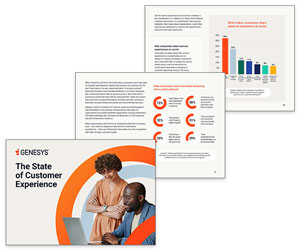Brendan Dykes of Genesys discusses the growing importance of making digital experiences easy and suggests how you can do so.
On the London Underground or Tube, as it’s often called, the phrase “MIND THE GAP” is painted on platforms, posted on train cars and announced upon arrival at stations. This phrase warns riders that the gap between the train and the platform could be a tripping hazard.
In customer engagement, “mind the gap” warns us of dangerous missteps. A gap leads to experiential stumbles and falls.
The rise in multichannel touchpoints has complicated the end-to-end customer journey. An increased use of mobile devices that enable easy access to a multitude of channels further complicates how we manage that journey. Still, customers expect to receive consistent and personalised experiences—no matter which channels they use.
The “Genesys State of Customer Experience” research report found that millennials consider technology to be an extension of themselves. They use it intuitively and expect everyone else to do the same.
Agents and service representatives from this generation are no different. These digital natives expect all their experiences to mimic their day-to-day mobile technology use, giving them the ability to move seamlessly among interactions and engagement channels.
The recent surge of mobile messaging platforms like Apple iMessage, Facebook Messenger, and WhatsApp Messenger offer more customer engagement opportunities.
According to the Genesys report, more than 80% of millennials use Facebook Messenger, as do more than half of the respondents aged 35 to 54.
However, the importance of mobile messaging for customer care varies significantly across the world. While 96% of respondents in Latin America rate it as either important or very important, only 54% in North America do.
The Customer Preference Disconnect
The rapid expansion of channels often leaves customers feeling confused about which to use and for which tasks. They’re frustrated when they’re forced to move between channels and go unrecognised by agents; customers don’t want to stay engaged with businesses who don’t understand their needs.
At the same time, businesses scramble to offer more communications channels without knowing which ones will succeed. Often, marketing, sales, and support teams use mobile messaging services before knowing if their customers want those services.
Some businesses rapidly deploy chatbots without truly understanding if customers want to use them. According to the “Genesys State of Customer Experience” research report, even though 66% of businesses plan to use some type of chatbot within the next six months, only 2% of consumers want to use them. All these missteps create silos.
Three Ways to Simplify Customer Engagement
Customer engagement shouldn’t be complicated. Customers shouldn’t have to repeat information as they engage over multiple channels. Agents should know what customers have done already. And the cost of adding a new channel should create greater savings elsewhere in your organisation.
It’s time to mind the gap in customer experience—the gap that siloed channels create, the gap in agent knowledge when customers move between channels, and the gap in technology that isolates a customer engagement within a single system. If you don’t address these, you risk wasting money on siloed solutions as well as frustrating customers.
Minding the gap in customer experience requires a three-pronged approach:
- Look at the big picture: As you offer more channels, more customers will demand, use and move among them.
- Develop seamless solutions: Don’t let customers fall through the gaps. They need to be known and understood—whenever and wherever they engage.
- Move from siloed to synchronous: Customers will engage in more than one channel at a time. You must understand this and engage accordingly.
Achieving these points will benefit both your business and your customers. Customers will feel recognised and understood when they make contact, which leads to greater lifetime value and increased recommendations.

Brendan Dykes
Also, your business will reduce the time it takes to relearn about customers, which allows you to better utilise resources across multiple channels and reduce the cost of technology by leveraging core data and capabilities, such as routing.
Mind the gap, examine what each department and team needs, create a transformational plan and then build a seamless customer engagement experience.
Author: Robyn Coppell
Published On: 18th Mar 2019 - Last modified: 27th Sep 2024
Read more about - Guest Blogs, Brendan Dykes, Genesys






































